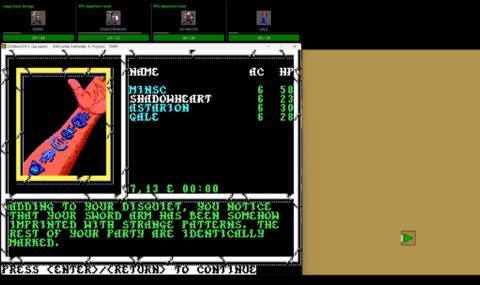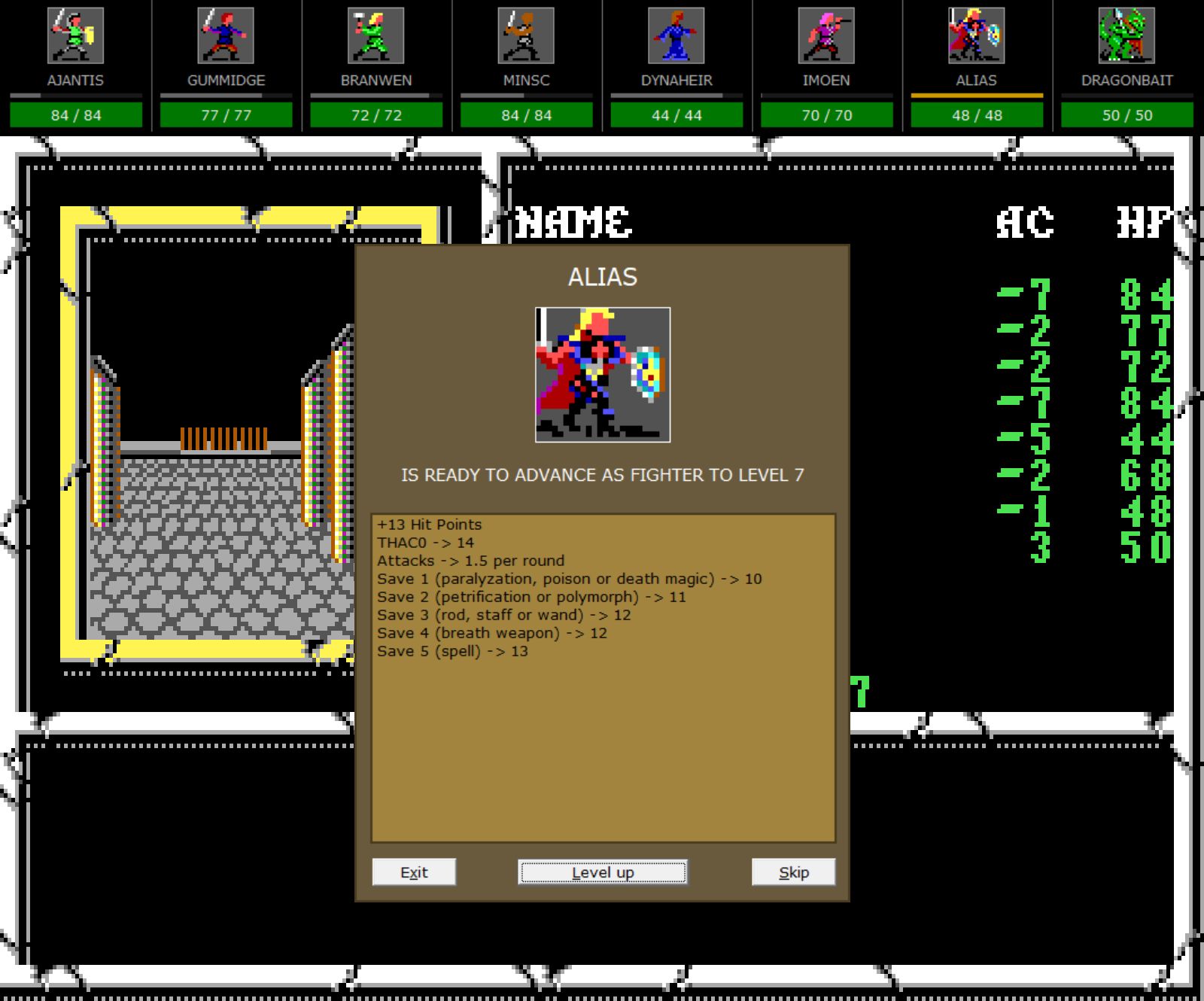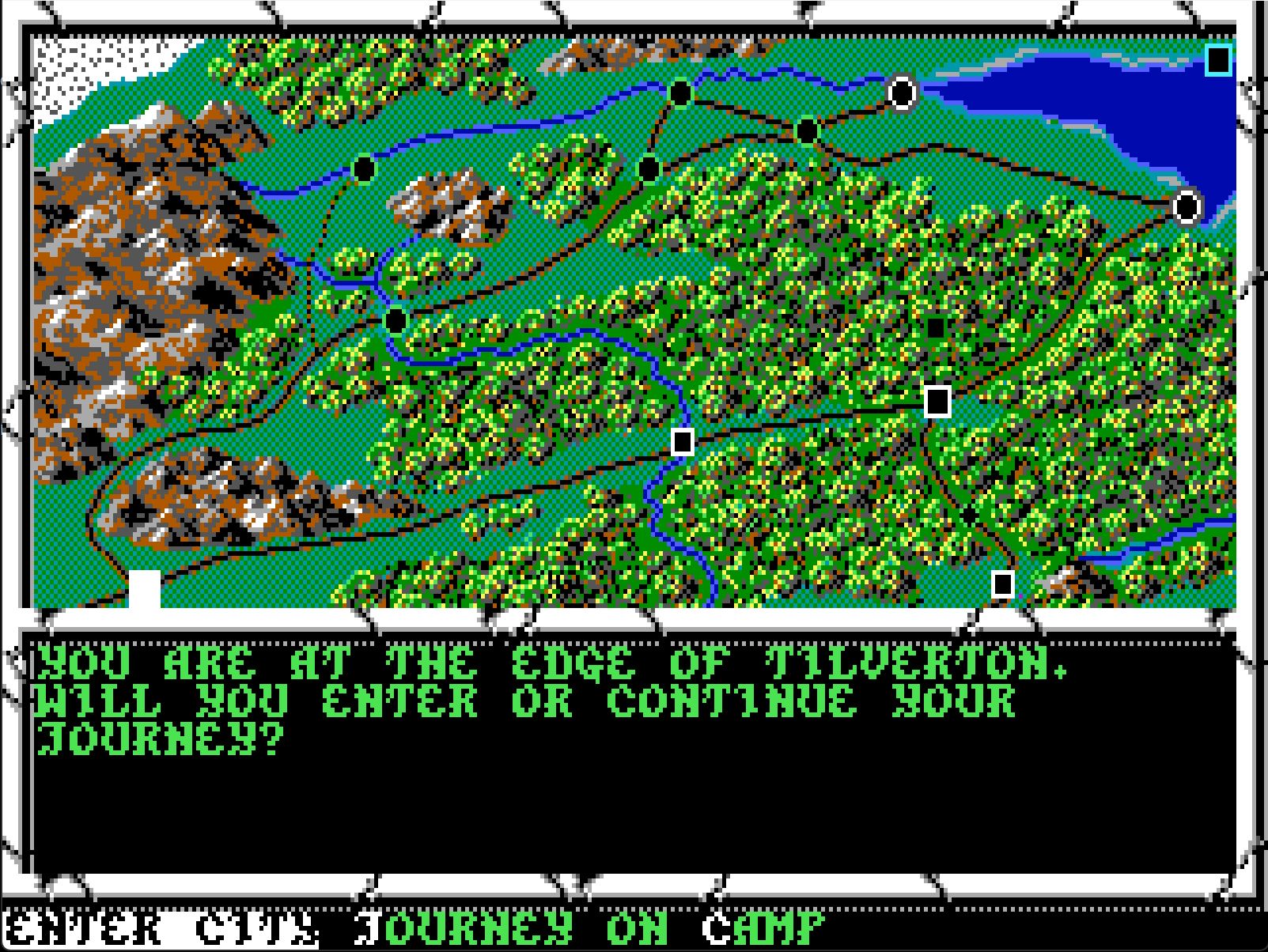Reinstall invites you to join us in revisiting PC gaming days gone by. Today, Jody returns to the Forgotten Realms to figure out what exactly he's forgotten about.
Years before Baldur's Gate came along, the CRPGS made in the Gold Box engine, including Curse of the Azure Bonds, were my introduction to the Forgotten Realms. Which is why I'll always associate it with women in impractical armour and names that can't be taken seriously. In Curse that's the priest Gharri of Gond and the villainous Fzoul Chembryl, though a few years later Forgotten Realms: Unlimited Adventures would introduce the unforgettable Lunit Bdufe, a name that makes Drizzt Do'Urden seems downright mundane.
The Gold Box games also introduced me to factions like the Zhentarim and the Red Wizards of Thay, two of the organisations in Curse of the Azure Bonds trying to control you via the magic tattoos of the title. Nothing can ever be just “blue” in a fantasy novel when it could be azure or sapphire or cerulean, right? I think Hoodoo of the Blue Tattoo would have been an even better name myself.
Curse kicks off when you wake up with magic tattoos and a month of missing memories. When those tattoos compel you to attack a local royal, you learn they're a medium for mind control and set out to get them removed.
The assassination attempt leads to a jail break and chase through the sewers where you encounter monsters made of garbage called otyughs. The sewer section is a highlight—not a sentence you get to write about videogames often—and one reason is that you can talk to the monsters. Some of the otyughs are jealous of their otyugh neighbours, so you can befriend them by stealing the superior piles of excrement next door. There are a handful of moments like this scattered across Curse, where you can cut a deal with a dark elf (but she'll only talk to you if there's a woman in your party), or avoid a fight with salamanders (but only if you choose the correct conversational tone out of a selection including haughty, nice, and meek).
The other reason this sewer chase stands out is how much story's jammed into it. There's a conflict between the thieves guild who helped bust you out of prison and a rival gang of criminals called the Fire Knives, both fighting over the prime thief real estate of the sewers. The Fire Knives were one of the parties involved in giving you the tattoos, and you stumble across the remains of their previous experiments as you rush through their base, following the trail of two other adventurers separately on the loose in the sewers. Gharri of Ghond is here to rescue a princess like he's playing a different videogame, and Olive Ruskettle—a halfling from the novel this game is based on—is one step ahead of you in the tunnels as well.
This is Curse of the Azure Bonds at its peak. CRPGs at the time rarely had this much narrative going on, with exceptions like the Ultima games. You were much more likely to be playing a dungeon dice-and-slice than something with actual mystery and plot. It helps that it's based on a book, just called Azure Bonds, which was nothing special but still more readable than 90% of the D&D novels—not that you need to read it to play the videogame. I hadn't the first time I played Curse but still appreciated when an NPC from the book would show up because they'd suddenly have more backstory and personality than everyone around them just by dint of not having been created for a videogame.

Cherished Companion
The Steam release of the Gold Box games comes with an app called the Gold Box Companion, which can be downloaded separately for other versions. It bolts an automap onto the right side of the game window so you don't have to bust out graph paper, and adds a status bar to the top that transforms into a menu of quality-of-life improvements when you mouse over it.
They include the ability to read journal entries as you find them rather than having to open up a pdf, because this is a game from the days when developers would save disk space by putting half the story in a book with numbered paragraphs you'd consult as you played. If you lost the thing, or your second-hand copy didn't have one, you'd never find out what Gorgax told you in paragraph 33.
An undersung hero of the Gold Box Companion is the ability to store your current list of memorised spells and then restore them at the press of a button instead of having to go through after each fight re-memorising every stinking cloud and fireball you cast. But the most indispensable thing about it is that it lets you ignore racial level limits.

Curse of the Azure Bonds is based on the rules of Advanced Dungeons & Dragons 1st Edition, which are a real ball-ache for many reasons, not least that they hate non-humans. Some classes are only available to humans, like paladin and ranger, and those that aren't are often restricted. Your cleric can be a half-elf if you like, but you'll never be allowed to go higher than level 5—and that's the level Curse starts at.
D&D's co-creator Gary Gygax thought of D&D as a work of sword and sorcery like Conan or the stories of Fritz Leiber and Jack Vance, which are amoral and human-centric. Surprisingly, he wasn't a fan of high fantasy like The Lord of the Rings, a deeply moral story about people from different backgrounds coming together to save the world, and while he put elves and dwarves in his game because players asked for them he made playing one an absolute pain in the dickhole. Fortunately later editions of D&D ditched all that nonsense and now everyone's party is a mix of elves, tieflings, and dragonborn, but back in the day D&D really wanted you to eat your vegetables and be a boring human.

While some of the rules were annoying, sticking to them meant Curse of the Azure Bonds really did feel like playing D&D. In a time when it was much harder to find a group than it is today, Curse was the methadone that would cover your need for a fix. That similarity was most obvious in the combat. My preference for turn-based tactical combat probably goes back to Curse of the Azure Bonds, where thieves would only get bonus backstab damage on enemies who had been attacked from the front earlier that round and timing was everything.
Some actions took longer than others, splitting your turn over multiple initiative counts. When an enemy priest started praying the next character in the turn order would get a chance to interrupt with something fast like an arrow or a magic missile, breaking his concentration so he'd lose that hold person spell. Enemies would do the same trick, and the number of fireballs I lost because my wizard took chip damage from a random dark elf is infuriating. Area-denial spells like stinking cloud were the order of the day, and lightning bolt would rebound off walls, potentially bouncing back to strike twice. After playing a few games with this level of tactical possibility, the messy realtime-with-pause combat of Baldur's Gate felt like a betrayal—not how D&D was supposed to work.

The Gold Box Companion makes replaying Curse of the Azure Bonds more convenient than trying to finish it was when I was a kid. Back then, I never made it to the end. Now, armed with a walkthrough so I don't have to suffer through quite so many random encounters as I wander the wilderness trying to figure out where the plot picks up, I finally get to see what the back half of the game is like.
Turns out, not great. There are a lot less chatty otyughs and a lot more dungeon crawling. The enemies are clearly chosen for their level-appropriateness rather than to match the theme—a Red Wizard who is obsessed with dragons has an undead one as a pet, which makes sense, but most of his horde is made up of dark elves and efreets for no reason other than providing a balanced challenge for your current experience total. The final boss, a spirit capable of possessing anyone, has taken over a storm giant for no particular reason except his stat block. His minions are margoyles, a slightly tougher version of gargoyles, again for no reason. Defeat them and there's a rushed epilogue, some pixel fireworks, and an opportunity to save your party so you can take them into the next game.

Which I did, after going back to my final save to remove each character one by one because that's apparently how it works. Dragging the same party into the sequel, Secret of the Silver Blades, isn't really doing it for me. Much as I loved Curse of the Azure Bonds as a 12-year-old who only owned a handful of games and didn't have any friends who played D&D, now if I want that experience in videogame form I've got Baldur's Gate 3, Solasta: Crown of the Magister, and a couple of Pathfinder games to replay. Even better, I've got a real D&D game on the go and the players have just hit level 5.
Maybe for old time's sake I'll introduce some Red Wizards and Zhentarim into my campaign. Though probably not the impractical armour and unpronounceable names.






